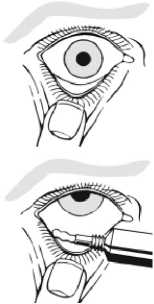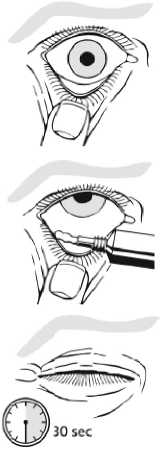Zovirax Eye Ointment
Ref: 0308/201213/1/F
Zovirax® Eye Ointment
(aciclovir)
Patient Information Leaflet


Read all of this leaflet carefully before you start using this medicine because it contains important information for you.
• Keep this leaflet. You may need to read it again.
• If you have any further questions, ask your doctor or pharmacist.
• This medicine has been prescribed for you only.
Do not pass it on to others. It may harm them, even if their signs of illness are the same as yours.
• If you get any side effects talk to your doctor or pharmacist. This includes any possible side effects not listed in this leaflet, see section 4.
Your medicine is called Zovirax Eye Ointment but will be referred to as Zovirax throughout the leaflet.
In this leaflet:
What Zovirax is and what it is used for What you need to know before you use Zovirax
^ How to use Zovirax Possible side effects ^ How to store Zovirax [6 Contents of the pack and other infromation
What Zovirax is and what it is used for
Zovirax Eye Ointment (called ‘Zovirax' in this leaflet) contains a medicine called aciclovir. This belongs to a group of medicines called antivirals. It is used to treat eye infections caused by the Herpes simplex virus. It works by killing or stopping the growth of viruses on the front of your eyeball (cornea).
What you need to know before you use Zovirax
Do not use Zovirax if:
• you are allergic (hypersensitive) to aciclovir or valaciclovir or any of the other ingredients (listed in Section 6).
If you are not sure, talk to your doctor or pharmacist before using Zovirax.
Warnings and precautions
Talk to your doctor or pharmacist before using Zovirax if:
• you wear contact lenses. Stop wearing them while using Zovirax.
If you are not sure, talk to your doctor or pharmacist before using Zovirax.
Other medicines and Zovirax
Please tell your doctor or pharmacist if you are taking or have recently taken any other medicines. This includes medicines obtained without prescription, including herbal medicines.
Pregnancy and breast-feeding
Ask your doctor or pharmacist for advice before using any medicine.
Driving and Using Machines
You may experience blurred vision after using Zovirax Eye Ointment. Do not drive or use any machines unless your vision is clear.
3 How to use Zovirax
Always use Zovirax exactly as your doctor has told you. You should check with your doctor or pharmacist if you are not sure.
Adults and children
• The usual dose is 1cm (about % an inch) of Zovirax applied to the infected eye five times a day.
You should space each application of Zovirax by four hours. Suggested times are: 7am, 11am, 3pm, 7pm and 11pm.
• You should carry on using Zovirax for at least 3 days after your eye has got better.
• Your vision may be blurred for 5 to 10 minutes after applying Zovirax. Wait until you can see clearly again before driving or using any tools or machines.
How to apply Zovirax to your eye
1 Wash your hands.
2 Use your finger to gently pull down the lower eyelid of your infected eye.
3 Tilt your head slightly backwards and look up.
4 Apply 1cm (about % an inch) of Zovirax to the inside of your lower eyelid. Try to avoid the tip of the tube touching any part of your eye.
5 Close your eye for 30 seconds.
6 Wash your hands after applying Zovirax.
If you use more Zovirax than you should
Talk to your doctor or pharmacist if you use too much Zovirax. Zovirax eye ointment is for use in the eye, if you swallow any talk to your doctor or pharmacist.
If you forget to use Zovirax
• If you forget to use Zovirax, use it as soon as you remember. However, if it is nearly time for your next application, skip the missed application.
• Do not use a double application to make up for a forgotton application.
Like all medicines, Zovirax can cause side effects, although not everybody gets them. The following side effects may happen with this medicine:
Allergic reactions (affects less than 1 in 10,000 people)
If you have an allergic reaction, stop using Zovirax and see a doctor straight away. The signs may include:
• rash, itching or hives on your skin
• swelling of your face, lips, tongue or other parts of your body
• shortness of breath, wheezing or trouble breathing
• unexplained fever (high temperature) and feeling faint, especially when standing up.
Other side effects include:
Very common (affects more than 1 in 10 people)
• irritation or feeling as if there is something in your eye.
Common (affects less than 1 in 100 people)
• mild stinging in your eye straight after using Zovirax
• swollen, runny eyes (conjunctivitis).
Rare (affects less than 1 in 1,000 people)
• swollen eyelids.
If any of the side effects gets serious, or if you notice any side effects not listed in this leaflet, please tell your doctor or pharmacist.
Reporting of side effects
If you get any side effects, talk to your doctor, pharmacist or nurse. This includes any possible side effects not listed in this leaflet. You can also report side effects directly via the Yellow Card Scheme at www.mhra.gov.uk/yellowcard.
By reporting side effects, you help provide more information on the safety of this medicine.
Manufacturer and Licence Holder
Zovirax is manufactured by Jubilant HollisterStier General Partnership., Quebec, Canada and are procured from within the EU and repackaged by the Product Licence Holder: Lexon (UK) Limited, Unit 18, Oxleasow Road, East Moons Moat, Redditch, Worcestershire, B98 0RE.
POM PL Number: 15184/0308
Leaflet revision date: 20/12/13
Zovirax is a registered trademark of the GlaxoSmithKline Group of Compaines.
Blind or partially sighted?
Is this leaflet hard to see or read? Phone Lexon (UK) Limited,
Tel: 01527 505414 for help.
[4 How to store Zovirax
• KEEP OUT OF THE SIGHT AND REACH OF CHILDREN.
• Do not store above 25°C.
• Use within one month of opening.
• Keep the tube tightly closed when you are not using the ointment.
Do not use this medicine after the expiry date shown on the carton label or tube strip. If your doctor tells you to stop using this medicine, return any unused medicine to your pharmacist (chemist) for safe disposal. Only keep this medicine, if your doctor tells you to. If your medicine become discoloured or shows any other signs of deterioration, consult your pharmacist (chemist) who will tell you what to do.
[4 Contents of the pack and other infromation
What Zovirax contains
Each tube contains 3% w/w of aciclovir as the active ingredient. Inactive ingredient: white soft paraffin.
What Zovirax looks like and contents of the pack Zovirax is a white coloured, ophthalmic ointment in a tube with a tamper evident screw cap. Each tube contains 4.5g of ointment.
Patient Information Leaflet
Read all of this leaflet carefully before you start using this medicine because it contains important information for you.
• Keep this leaflet. You may need to read it again.
• If you have any further questions, ask your doctor or pharmacist.
• This medicine has been prescribed for you only.
Do not pass it on to others. It may harm them, even if their signs of illness are the same as yours.
• If you get any side effects talk to your doctor or pharmacist. This includes any possible side effects not listed in this leaflet, see section 4.
Your medicine is called Aciclovir Eye Ointment but will be referred to as Aciclovir throughout the leaflet.
In this leaflet:
9 What Aciclovir is and what it is used for 9 What you need to know before you use Aciclovir
9 How to use Aciclovir [4 Possible side effects [5 How to store Aciclovir 9 Contents of the pack and other infromation
Pregnancy and breast-feeding
Ask your doctor or pharmacist for advice before using any medicine.
Driving and Using Machines
You may experience blurred vision after using Zovirax Eye Ointment. Do not drive or use any machines unless your vision is clear.
9 How to use Aciclovir
Always use Aciclovir exactly as your doctor has told
you. You should check with your doctor or
pharmacist if you are not sure.
Adults and children
• The usual dose is 1cm (about % an inch) of Aciclovir applied to the infected eye five times a day.
You should space each application of Aciclovir by four hours. Suggested times are: 7am, 11am,
3pm, 7pm and 11pm.
• You should carry on using Aciclovir for at least 3 days after your eye has got better.
• Your vision may be blurred for 5 to 10 minutes after applying Aciclovir. Wait until you can see clearly again before driving or using any tools or machines.

9 What Aciclovir is and what it is used for
Aciclovir Eye Ointment (called ‘Aciclovir' in this leaflet) contains a medicine called aciclovir. This belongs to a group of medicines called antivirals. It is used to treat eye infections caused by the Herpes simplex virus. It works by killing or stopping the growth of viruses on the front of your eyeball (cornea).
9 What you need to know before you use Aciclovir
Do not use Aciclovir if:
• you are allergic (hypersensitive) to aciclovir or valaciclovir or any of the other ingredients (listed in Section 6).
If you are not sure, talk to your doctor or pharmacist before using Aciclovir.
Warnings and precautions
Talk to your doctor or pharmacist before using Zovirax if:
• you wear contact lenses. Stop wearing them while using Zovirax.
If you are not sure, talk to your doctor or pharmacist before using Zovirax.
Other medicines and Aciclovir
Please tell your doctor or pharmacist if you are taking or have recently taken any other medicines. This includes medicines obtained without prescription, including herbal medicines.
How to apply Aciclovir to your eye
1 Wash your hands.
2 Use your finger to gently pull down the lower eyelid of your infected eye.
3 Tilt your head slightly backwards and look up.
4 Apply 1cm (about % an inch) of Aciclovir to the inside of your lower eyelid. Try to avoid the tip of the tube touching any part of your eye.
5 Close your eye for 30 seconds.
6 Wash your hands after applying Aciclovir.
If you use more Aciclovir than you should
Talk to your doctor or pharmacist if you use too much Aciclovir. Aciclovir eye ointment is for use in the eye, if you swallow any talk to your doctor or pharmacist.
If you forget to use Aciclovir
• If you forget to use Aciclovir, use it as soon as you remember. However, if it is nearly time for your next application, skip the missed application.
• Do not use a double application to make up for a forgotton application.
Like all medicines, Aciclovir can cause side effects, although not everybody gets them. The following side effects may happen with this medicine:
Allergic reactions (affects less than 1 in 10,000 people)
If you have an allergic reaction, stop using Aciclovir and see a doctor straight away. The
signs may include:
• rash, itching or hives on your skin
• swelling of your face, lips, tongue or other parts of your body
• shortness of breath, wheezing or trouble breathing
• unexplained fever (high temperature) and feeling faint, especially when standing up.
Other side effects include:
Very common (affects more than 1 in 10 people)
• irritation or feeling as if there is something in your eye.
Common (affects less than 1 in 100 people)
• mild stinging in your eye straight after using Aciclovir
• swollen, runny eyes (conjunctivitis).
Rare (affects less than 1 in 1,000 people)
• swollen eyelids.
If any of the side effects gets serious, or if you notice any side effects not listed in this leaflet, please tell your doctor or pharmacist.
Reporting of side effects
If you get any side effects, talk to your doctor, pharmacist or nurse. This includes any possible side effects not listed in this leaflet. You can also report side effects directly via the Yellow Card Scheme at www.mhra.gov.uk/yellowcard.
By reporting side effects, you help provide more information on the safety of this medicine.
Manufacturer and Licence Holder
Aciclovir is manufactured by Jubilant HollisterStier General Partnership., Quebec, Canada and are procured from within the EU and repackaged by the Product Licence Holder: Lexon (UK) Limited, Unit 18, Oxleasow Road, East Moons Moat, Redditch, Worcestershire, B98 0RE.
POM PL Number: 15184/0308 Leaflet revision date: 20/12/13
Blind or partially sighted?
Is this leaflet hard to see or read? Phone Lexon (UK) Limited,
Tel: 01527 505414 for help.
Q How to store Aciclovir
• KEEP OUT OF THE SIGHT AND REACH OF CHILDREN.
• Do not store above 25°C.
• Use within one month of opening.
• Keep the tube tightly closed when you are not using the ointment.
Do not use this medicine after the expiry date shown on the carton label or tube strip. If your doctor tells you to stop using this medicine, return any unused medicine to your pharmacist (chemist) for safe disposal. Only keep this medicine, if your doctor tells you to. If your medicine become discoloured or shows any other signs of deterioration, consult your pharmacist (chemist) who will tell you what to do.
Q Contents of the pack and other infromation
What Aciclovir contains
Each tube contains 3% w/w of aciclovir as the active ingredient. Inactive ingredient: white soft paraffin.
What Aciclovir looks like and contents of the pack
Aciclovir is a white coloured, ophthalmic ointment in a tube with a tamper evident screw cap. Each tube contains 4.5g of ointment.
Ref: 0308/201213/2/B